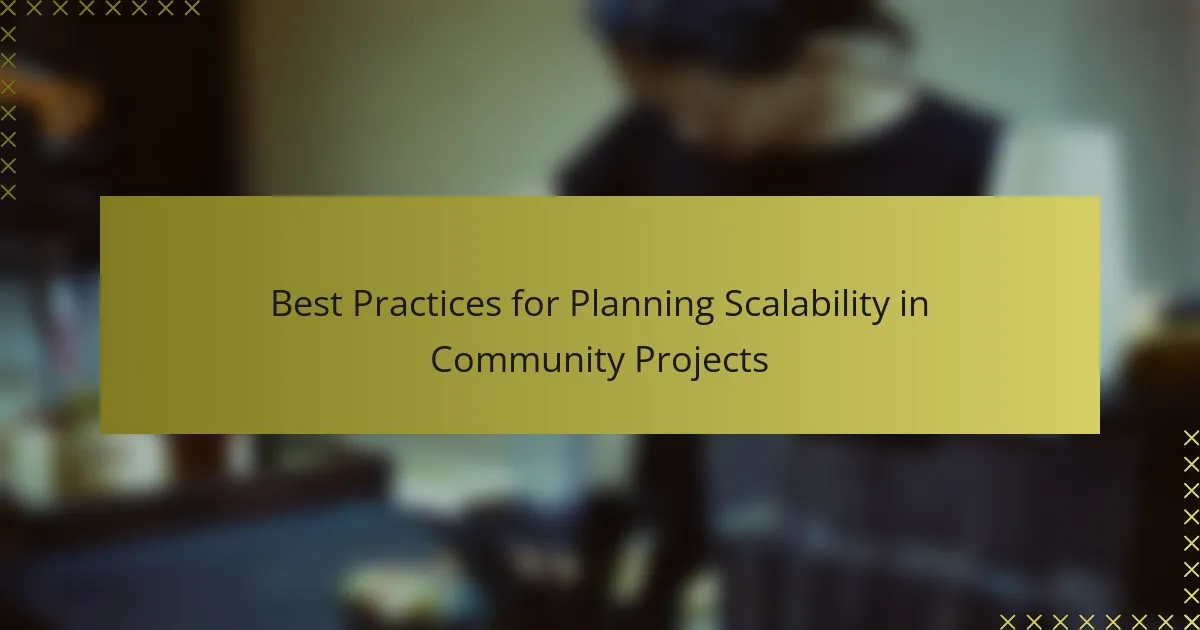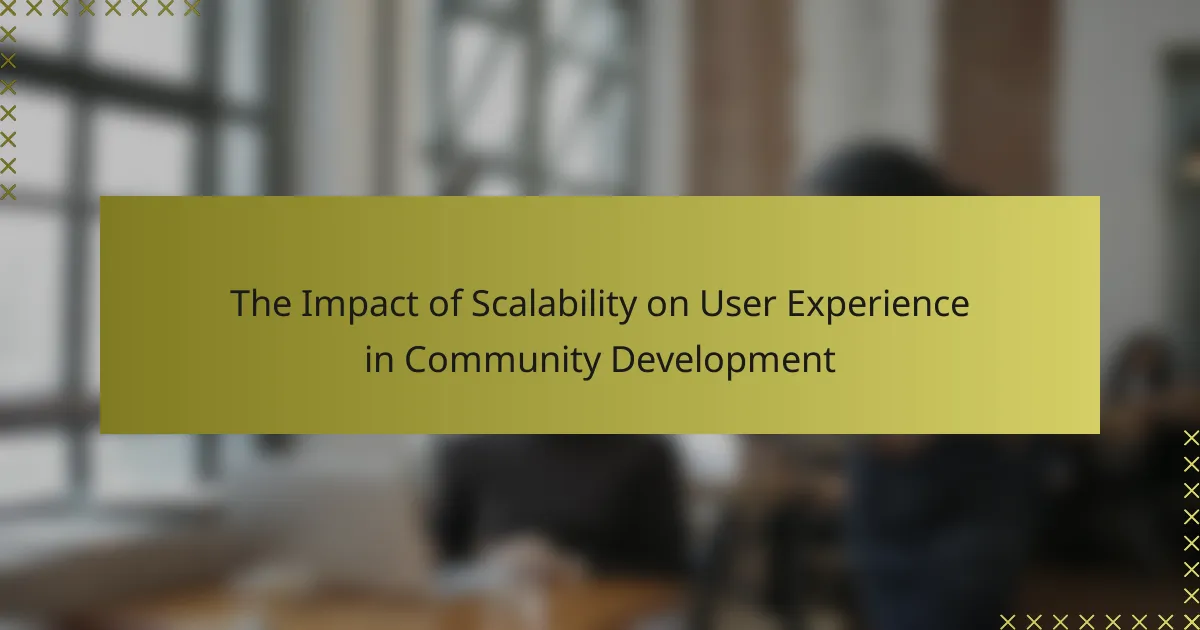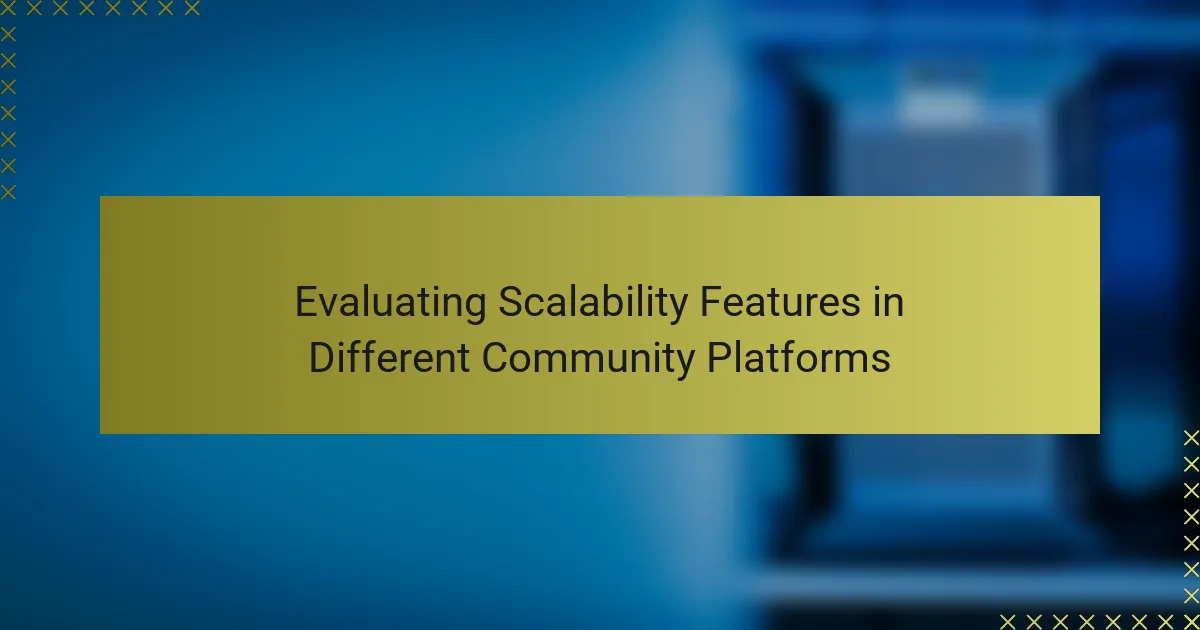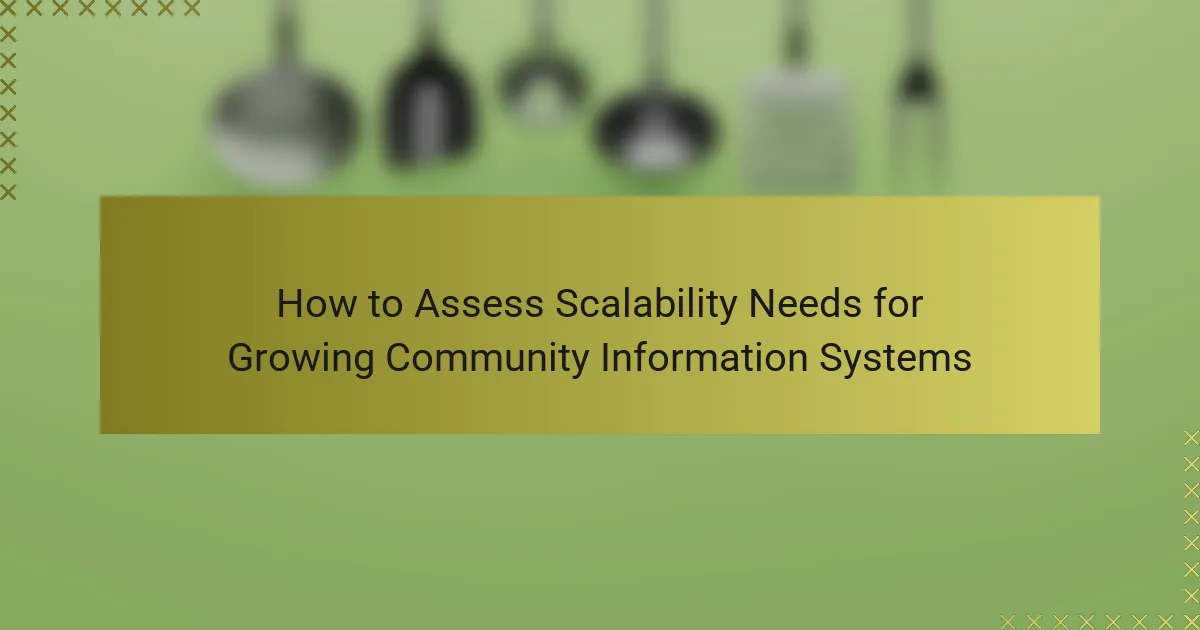Effective planning for scalability in community projects is essential to ensure that initiatives can expand while maintaining their impact. By setting clear goals, engaging stakeholders, and leveraging technology, projects can foster sustainable growth and adaptability. Incorporating feedback systems and creating a structured roadmap further enhances the potential for success as the community evolves.

What are the best practices for planning scalability in community projects?
Planning scalability in community projects involves strategic foresight to ensure that initiatives can grow effectively without losing impact. Key practices include setting clear goals, engaging stakeholders, leveraging technology, implementing feedback systems, and creating a roadmap for growth.
Define clear project goals
Establishing clear project goals is essential for scalability. These goals should be specific, measurable, achievable, relevant, and time-bound (SMART). For example, instead of a vague goal like “increase community engagement,” aim for “increase participation in events by 30% over the next year.”
Documenting these goals helps align team efforts and provides a benchmark for measuring success. Regularly revisiting and adjusting these goals ensures they remain relevant as the project evolves.
Engage community stakeholders
Engaging community stakeholders is crucial for building support and ensuring the project’s relevance. Identify key groups, such as local organizations, residents, and potential beneficiaries, and involve them in the planning process. This can be done through surveys, focus groups, or community meetings.
Active participation fosters a sense of ownership among stakeholders, which can lead to increased commitment and resource sharing. Regular updates and open communication channels help maintain engagement throughout the project’s lifecycle.
Utilize scalable technologies
Choosing the right technologies can significantly impact a project’s scalability. Opt for platforms and tools that can handle increased demand without compromising performance. For instance, cloud-based solutions often provide flexibility and scalability compared to traditional software.
Consider adopting open-source tools that allow for customization and community contributions, which can enhance functionality as the project grows. Regularly assess technology needs and be prepared to adapt as requirements change.
Implement feedback mechanisms
Feedback mechanisms are vital for understanding community needs and improving project effectiveness. Establish channels for receiving input, such as online surveys, suggestion boxes, or regular check-ins with stakeholders. This allows for continuous improvement based on real-world experiences.
Incorporate feedback into decision-making processes to ensure that the project remains aligned with community expectations. Regularly reviewing feedback can also help identify potential scalability issues before they become significant problems.
Establish a growth roadmap
A growth roadmap outlines the steps needed to scale the project effectively. This should include short-term and long-term objectives, resource allocation, and potential challenges. For example, a roadmap might detail phases of expansion, such as increasing outreach efforts or adding new services.
Regularly updating the roadmap based on progress and changing circumstances ensures that the project remains on track. Involving stakeholders in this process can provide valuable insights and foster a collaborative approach to growth.

How can community engagement enhance scalability?
Community engagement significantly enhances scalability by fostering a sense of ownership and commitment among members. When individuals feel connected to a project, they are more likely to contribute actively, which can lead to sustainable growth and adaptability.
Build trust through transparency
Transparency is crucial in building trust within a community. By openly sharing project goals, challenges, and decision-making processes, members feel valued and informed, which encourages their participation. Regular updates and clear communication can help mitigate misunderstandings and foster a collaborative environment.
Consider implementing tools like community newsletters or public forums where updates can be shared. This approach not only keeps everyone informed but also invites feedback, reinforcing trust and commitment.
Foster collaboration among members
Collaboration among community members can significantly enhance project scalability. By creating opportunities for members to work together, you can leverage diverse skills and perspectives, leading to innovative solutions and a stronger community bond. Organizing workshops or collaborative events can facilitate this process.
Utilizing platforms that support teamwork, such as shared online workspaces or project management tools, can streamline collaboration. Encourage members to share their expertise and resources, which can lead to more effective problem-solving and project advancement.
Encourage diverse participation
Diverse participation is essential for scalability as it brings in varied viewpoints and experiences. Actively seeking input from underrepresented groups can enrich the project and help identify unique challenges and opportunities. This can be achieved through targeted outreach and inclusive practices.
Consider hosting events in different community locations or offering incentives for participation, such as small grants or recognition programs. Ensuring that all voices are heard can lead to a more resilient and adaptable project, capable of meeting the needs of a broader audience.

What technologies support scalability in community projects?
Technologies that support scalability in community projects include project management tools, communication platforms, and data management systems. These tools help streamline processes, enhance collaboration, and manage growing amounts of information effectively.
Project management tools like Asana
Project management tools such as Asana enable teams to organize tasks, set deadlines, and track progress efficiently. They allow for clear visibility into project timelines and responsibilities, which is crucial as community projects expand.
When using Asana, consider creating templates for recurring tasks and projects to save time. Regularly review and adjust workflows to accommodate new team members and changing project scopes.
Communication platforms such as Slack
Communication platforms like Slack facilitate real-time discussions and information sharing among team members. These tools help maintain engagement and ensure that everyone is on the same page, especially in larger community projects.
To optimize Slack for scalability, create dedicated channels for specific topics or projects. This organization helps prevent information overload and allows team members to focus on relevant discussions. Regularly encourage updates and check-ins to keep communication flowing.
Data management systems like Airtable
Data management systems such as Airtable provide a flexible way to organize and analyze information. They can handle various data types and allow for easy collaboration, which is essential for managing the growing data needs of community projects.
Utilize Airtable’s templates for different types of data management, such as event planning or volunteer tracking. Ensure that data entry processes are standardized to maintain consistency and accuracy as your project scales. Regularly back up data to prevent loss and ensure accessibility for all team members.

What are the key metrics for measuring scalability?
Key metrics for measuring scalability include community growth rate, engagement levels, and resource allocation efficiency. These metrics help assess how well a community project can expand and adapt to increasing demands while maintaining performance and effectiveness.
Community growth rate
The community growth rate measures how quickly a project is attracting new members. A healthy growth rate typically ranges from 5% to 20% monthly, depending on the project’s nature and outreach efforts. Monitoring this rate helps identify trends and potential areas for improvement.
To effectively track growth, consider using tools like Google Analytics or social media insights. Regularly analyze the data to understand which strategies are working and where adjustments may be needed.
Engagement levels
Engagement levels reflect how actively community members participate in discussions, events, and activities. High engagement is often indicated by metrics such as comments, likes, shares, and attendance at events. Aim for at least 30% of members to regularly engage with content or activities.
To boost engagement, create interactive content, host regular events, and encourage feedback. Avoid common pitfalls like overwhelming members with information or failing to recognize their contributions, as this can lead to disengagement.
Resource allocation efficiency
Resource allocation efficiency assesses how well a community project utilizes its available resources, including time, money, and personnel. Efficient allocation can lead to better outcomes and sustainability. A good practice is to aim for at least 70% of resources directed toward core activities that drive growth and engagement.
To improve efficiency, regularly review resource distribution and adjust based on project needs. Consider implementing budgeting tools or project management software to track expenses and resource usage effectively. Avoid spreading resources too thin across too many initiatives, as this can dilute impact.

What frameworks can guide scalability decisions?
Frameworks such as SWOT analysis and logic models are essential for guiding scalability decisions in community projects. They help identify strengths, weaknesses, opportunities, and threats, as well as clarify project objectives and resources needed for expansion.
SWOT analysis for community projects
SWOT analysis involves evaluating the internal strengths and weaknesses of a project alongside external opportunities and threats. This framework allows project leaders to pinpoint areas for growth and potential challenges that could hinder scalability.
For instance, a community project may have strong volunteer support (strength) but limited funding (weakness). Identifying local partnerships (opportunity) and potential competition (threat) can inform strategic decisions. Regularly revisiting the SWOT analysis ensures that the project adapts to changing circumstances.
Logic models for project planning
Logic models provide a visual representation of how a community project will achieve its goals, outlining inputs, activities, outputs, and outcomes. This structured approach helps clarify the resources required and the expected impact, making it easier to plan for scalability.
For example, a logic model might show that increased volunteer training (input) leads to more community events (activity), which in turn results in higher community engagement (output) and improved local well-being (outcome). By aligning activities with desired outcomes, project leaders can better allocate resources and anticipate scaling needs.
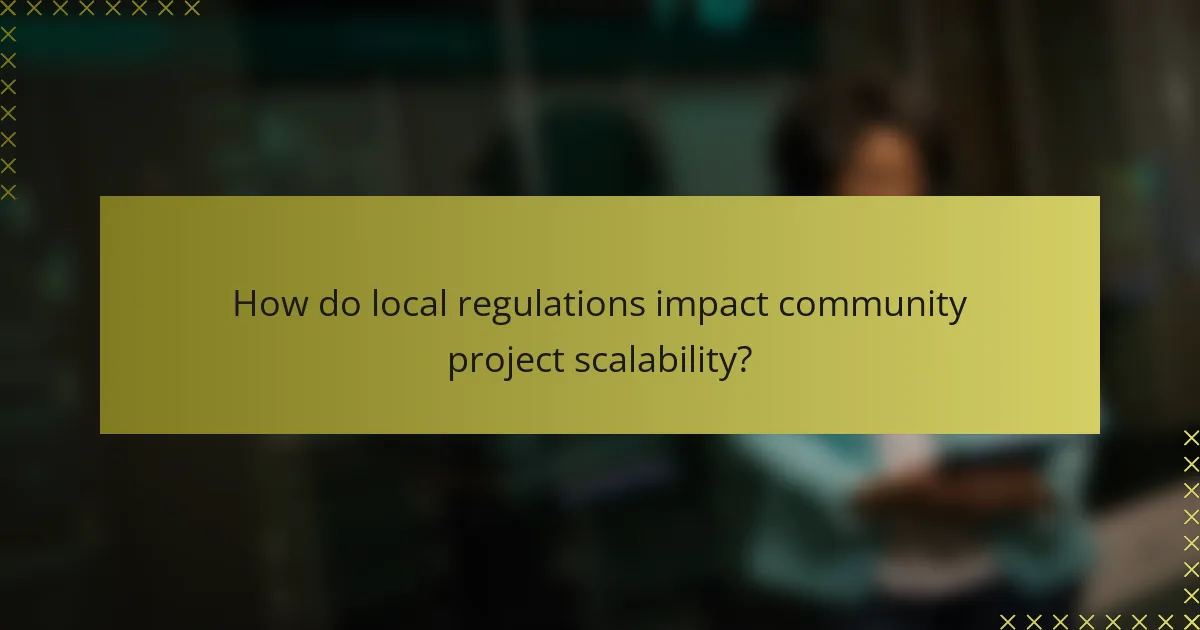
How do local regulations impact community project scalability?
Local regulations significantly influence the scalability of community projects by dictating what can be built, where, and how. Understanding these regulations is crucial for ensuring that projects can expand and adapt over time without facing legal hurdles.
Compliance with zoning laws
Compliance with zoning laws is essential for any community project aiming for scalability. Zoning regulations determine land use, building heights, and density, which can directly affect a project’s ability to grow. For instance, a project designed for residential use may face restrictions if it seeks to expand into commercial activities.
When planning for scalability, assess the zoning classifications in your area. Many municipalities have specific zoning codes that outline permissible uses and development standards. Engaging with local planning departments early can help identify potential zoning challenges and opportunities for variances.
Consider the possibility of mixed-use developments, which can often navigate zoning restrictions more flexibly. Projects that combine residential, commercial, and recreational spaces may benefit from broader acceptance and support from local authorities, facilitating future expansion.
